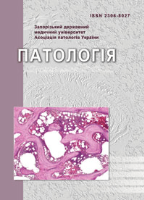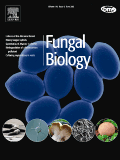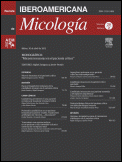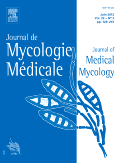
Medical Mycology Journal
Scope & Guideline
Exploring Innovative Solutions for Fungal Pathogens
Introduction
Aims and Scopes
- Fungal Pathogenesis and Virulence Mechanisms:
Research exploring the mechanisms by which fungi cause disease, including studies on virulence factors, host-pathogen interactions, and environmental influences on fungal pathogenicity. - Antifungal Therapy and Drug Resistance:
Investigation into antifungal treatments, including optimal therapeutic strategies, drug resistance mechanisms, and the development of new antifungal agents. - Diagnostic Innovations in Mycology:
Focus on improving diagnostic methods for fungal infections, including molecular techniques, serological assays, and the identification of novel biomarkers for various fungal diseases. - Epidemiology of Fungal Infections:
Studies examining the distribution, prevalence, and trends of fungal infections in different populations, alongside the impact of environmental factors on fungal epidemiology. - Clinical Case Studies and Guidelines:
Publication of clinical case reports and evidence-based guidelines to inform practitioners about the diagnosis and management of fungal diseases. - Mycobiome Research:
Exploration of the human mycobiome and its association with health and disease, including the role of fungal communities in human microbiomes.
Trending and Emerging
- Antifungal Stewardship and Resistance Management:
There is a growing emphasis on antifungal stewardship programs aimed at optimizing antifungal use and managing resistance, reflecting global health priorities in combating fungal infections. - Role of Artificial Intelligence in Diagnostics:
Emerging research on the application of artificial intelligence in the diagnosis of fungal infections is gaining traction, indicating a trend towards integrating technology with clinical mycology. - In Vivo Models for Fungal Research:
Increased utilization of in vivo models, such as silkworm and murine models, for studying fungal infections and treatment efficacy suggests a trend towards more relevant experimental frameworks. - Molecular Epidemiology and Genomic Studies:
A rise in molecular epidemiology studies, including genomic analyses to understand the spread and resistance mechanisms of fungal pathogens, indicates a focus on precision medicine. - Exploration of Mycobiome and Associated Diseases:
Research into the human mycobiome and its implications for health and disease is emerging as a significant area of interest, highlighting the complex interactions between fungi and human health.
Declining or Waning
- Traditional Culture Methods for Fungal Identification:
There has been a noticeable decrease in studies focusing solely on classical culture methods for identifying fungal pathogens, as molecular techniques gain prominence in diagnostics. - Non-Specific Antifungal Agents:
Research centered on broad-spectrum antifungal agents is waning, with a shift towards more targeted therapies and personalized medicine approaches in antifungal treatment. - Basic Taxonomic Studies without Clinical Relevance:
Taxonomic research that does not have clear clinical implications or applications is becoming less common, as the journal increasingly prioritizes studies that bridge basic research and clinical practice. - Environmental Mycology Studies with Limited Clinical Application:
Research focused purely on environmental mycology, such as studies on fungal biodiversity without direct implications for human health, is appearing less frequently.
Similar Journals

MYCOSCIENCE
Exploring the Hidden World of FungiMYCOSCIENCE, published by the Mycological Society of Japan, is a prominent peer-reviewed journal that serves as an essential resource in the fields of ecology, evolution, behavior, and systematics, highlighted by its Q2 ranking in the 2023 category quartiles. Established in 1994 and continuing through 2024, the journal focuses on mycological research, providing insights into the interconnected worlds of fungi and their ecological roles. With an ISSN of 1340-3540 and an E-ISSN of 1618-2545, MYCOSCIENCE aims to disseminate high-quality research that addresses current issues and trends within the discipline. Despite not being an open-access journal, it makes a significant contribution to advancing fungal biology and its applications in agriculture and environmental science, making it an invaluable asset for researchers, professionals, and students alike. Located in the vibrant academic environment of Tokyo, Japan, MYCOSCIENCE stands out for its dedication to fostering a deeper understanding of mycology and its implications for biodiversity and ecosystem health.

MYCOPATHOLOGIA
Illuminating the complexities of fungal interactions.MYCOPATHOLOGIA, published by Springer in the Netherlands, stands as a pivotal journal in the fields of mycology, plant science, and veterinary microbiology. With its extensive history dating back to 1938, this journal has consistently contributed to the understanding of fungal pathogens and their impact on both agriculture and animal health. It currently holds impressive rankings in Scopus, including Q1 status in Agronomy and Crop Science, and Q2 rankings in Applied Microbiology and Biotechnology, demonstrating its influence and rigor in the scientific community. Researchers and professionals benefit from its curated, high-quality studies which address critical areas such as plant-pathogen interactions and veterinary mycology. While not open access, MYCOPATHOLOGIA emphasizes comprehensive research output and serves as a vital resource for advancing knowledge and fostering innovation in its disciplines. The journal remains committed to disseminating valuable insights that drive forward both academic inquiry and practical applications in related fields, ensuring its relevance and importance in contemporary research.

Pathologia
Championing Open Access in Medical ResearchPathologia is a prominent open-access journal dedicated to advancing the field of clinical and experimental pathology, published by ZAPORIZHZHYA STATE MEDICAL UNIVERSITY. Established in 2013, the journal aims to provide a platform for researchers, clinicians, and students to share innovative research, case studies, and reviews that are critical to understanding disease mechanisms and improving diagnostic and therapeutic strategies. With a steady commitment to high-quality research dissemination and accessibility, this journal serves as an essential resource for those in the medical and health sciences fields. Researchers engaging with Pathologia can explore a diverse range of topics, including histopathology, molecular pathology, and laboratory medicine, promoting both scholarly discussion and practical applications. The journal's open-access model ensures that vital research findings are freely available to the global academic community, fostering a collaborative environment that is crucial for the advancement of pathology as a discipline.

Journal of Pediatric Infection
Exploring the complexities of childhood infections.Journal of Pediatric Infection is a vital academic resource dedicated to the ever-evolving field of infectious diseases in pediatric populations. Published by AVES YAYINCILIK in Turkey, this journal features a rigorous peer-review process and has established itself as a platform for innovative research from around the globe. Although currently categorized in the Q4 quartile for both Infectious Diseases and Pediatrics, Perinatology and Child Health, the journal's potential for growth is substantial, attracting contributions that aim to shed light on the complexities of infectious diseases affecting children. With a converged publication history from 2009 to 2024, the journal emphasizes the importance of advancing knowledge in pediatric health through systematic reviews, original research, and case studies. Its open access policy encourages unrestricted sharing of vital research findings, making it an essential read for researchers, clinicians, and students dedicated to improving pediatric healthcare outcomes.

Fungal Biology
Pioneering Insights into Fungal Biology and Its ImpactFungal Biology, published by Elsevier Science Ltd, is a premier journal dedicated to advancing the field of mycology and its interdisciplinary applications. With an ISSN of 1878-6146 and E-ISSN 1878-6162, this journal serves as a vital platform for researchers and professionals interested in the ecological, evolutionary, and genetic aspects of fungi, as well as their implications in infectious diseases and plant sciences. As of 2023, it proudly holds a Q2 ranking in Ecology, Evolution, Behavior and Systematics and Plant Science, and a Q3 ranking in Genetics and Infectious Diseases, highlighting its significant contribution to these domains. The journal boasts an impressive Scopus rank, including a percentile of 83rd in Ecological studies, ensuring that published research reaches a wide audience and impacts ongoing discourse in the field. With open access options, Fungal Biology encourages the dissemination of high-quality research, aimed to foster collaboration and innovation among scholars and practitioners. With its convergence of knowledge from 2010 to 2024, this journal is instrumental for those advancing the understanding of fungal biology and its myriad applications in environmental and health sciences.

REVISTA IBEROAMERICANA DE MICOLOGIA
Exploring the Frontiers of Mycology and Disease ResearchREVISTA IBEROAMERICANA DE MICOLOGIA, published by the ASOCIACION ESPANOLA MICOLOGIA-AEM, is a vital resource for those engaged in the study of mycology and infectious diseases. With a history spanning from 1996 to 2024, this journal is committed to advancing knowledge in the field through the dissemination of high-quality research articles, reviews, and case studies. Although it currently features a Q3 ranking in Infectious Diseases and a Q4 ranking in Microbiology for 2023, its impact is significant given the niche focus it serves, catering to a specialized audience of researchers and practitioners. While access is not open, the journal continues to be a preferred platform for scholarly communication among professionals in Spain and beyond. The editorial office, located in Bilbao, serves as the hub for rigorous peer-review and publication processes, ensuring that the latest advancements and findings in the field of mycology are effectively shared within the scientific community.

Current Fungal Infection Reports
Navigating the evolving landscape of fungal infection research.Current Fungal Infection Reports is an essential academic journal dedicated to the rapidly evolving field of mycology, specifically focusing on the diagnosis, treatment, and epidemiology of fungal infections. Published by Springer, this journal aims to provide a comprehensive platform for researchers, healthcare professionals, and scholars to disseminate groundbreaking findings and insights into the complexities surrounding fungal diseases. With an ISSN of 1936-3761 and an E-ISSN of 1936-377X, the journal is recognized in the Q3 category for Infectious Diseases as of 2023 and holds a Scopus rank of #199 out of 344 in its field, showcasing its growing influence. Although not currently open access, Current Fungal Infection Reports remains an important resource for those wishing to stay updated on key developments and trends within this critical area of global health. Through its commitment to advancing knowledge and fostering academic exchange, the journal plays a crucial role in combating the challenges posed by fungal infections, making it a must-read for anyone involved in infectious disease research and treatment.

Journal of Fungi
Elevating Scientific Discourse on FungiJournal of Fungi is a premier open-access journal published by MDPI, dedicated to advancing the understanding of fungal biology in its myriad forms. Since its inception in 2015, it has become a vital resource in the fields of ecology, evolution, and plant sciences, attaining notable rankings in Scopus, including Q1 status in Ecology, Evolution, Behavior and Systematics, and Plant Science, with a Q2 ranking in Microbiology (medical). The journal fosters a collaborative platform for researchers, professionals, and students by providing unrestricted access to high-quality, peer-reviewed articles, which encourages the dissemination of innovative findings and methodologies relevant to fungal research. Designed to cater to a global audience, the Journal of Fungi has established its significance in the scientific community, especially from its base in Switzerland, where it continues to contribute to the ongoing discourse in mycology and beyond. With its commitment to open access since its launch and its continuous support for groundbreaking research, the journal plays a crucial role in driving forward the scientific inquiry and ecological awareness in fungal studies.

Reviews and Research in Medical Microbiology
Your Essential Resource for Medical Microbiology AdvancementsReviews and Research in Medical Microbiology is a premier academic journal published by LIPPINCOTT WILLIAMS & WILKINS, focusing on groundbreaking research and comprehensive reviews that advance the understanding of medical microbiology. With an ISSN of 2770-3150 and an E-ISSN of 2770-3169, this journal serves as an essential resource for researchers, healthcare professionals, and students dedicated to the study of pathogens, infectious diseases, and microbial mechanisms affecting health. While the journal currently does not offer open access, its rigorous peer-review process ensures that only high-quality, impactful research is disseminated to the scientific community. The journal aims to bridge gaps in knowledge by presenting cutting-edge studies that explore novel therapeutic strategies, diagnostic methods, and the evolving landscape of microbial resistance. Nestled in the heart of Philadelphia, this journal proudly contributes to the advancement of medical microbiology and is an indispensable platform for the publication of critical findings that shape clinical practices and research trajectories in the field.

JOURNAL DE MYCOLOGIE MEDICALE
Empowering Knowledge in Fungal PathologyJOURNAL DE MYCOLOGIE MEDICALE is a premier publication in the field of infectious diseases, particularly focusing on the study of mycology and its clinical implications. Published by MASSON EDITEUR, this esteemed journal is based in France and has been disseminating valuable research since its inception in 1994. With an ISSN of 1156-5233 and an E-ISSN of 1773-0449, it plays a critical role in advancing knowledge in mycological infections, positioning itself in the Q3 category for infectious diseases as per the 2023 quartiles. As indicated by its ranking in Scopus, ranking #142 out of 344 in the medicine-infectious diseases category, the journal maintains a prominent presence within the academic community, appealing to researchers, healthcare professionals, and students alike. Although access options are not open access, the journal endeavors to promote a deeper understanding of mycological studies that are crucial for combating ongoing and emerging infectious threats. As it continues to converge on new findings up to 2024, JOURNAL DE MYCOLOGIE MEDICALE remains an essential resource for those invested in the critical intersections of mycology and medicine.